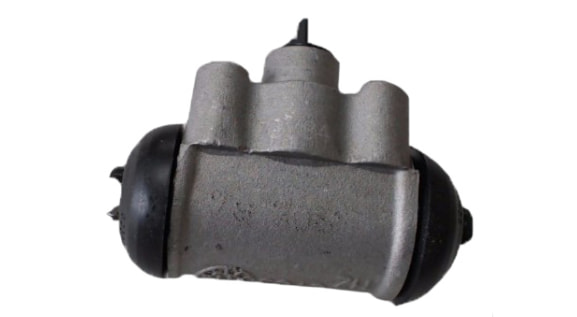The brake slave cylinder, though a relatively small component in a vehicle's braking system, plays a critical role in ensuring the safe and effective operation of the brakes. Understanding what a brake slave cylinder is, how it works, and its significance can help you maintain and repair your vehicle's brakes. In this comprehensive guide, we will cover everything you need to know about a brake slave cylinder.
What is a Brake Slave Cylinder?
The brake slave cylinder is a vital part of a vehicle's hydraulic braking system, particularly in systems with drum brakes, although some disc brake systems may also incorporate it. Its primary function is to convert hydraulic pressure into mechanical force, which in turn pushes the brake shoes or pads against the brake drum or rotor, resulting in the vehicle's deceleration or stopping.
How Does a Brake Slave Cylinder Work?
The operation of a brake slave cylinder is relatively straightforward, but its importance cannot be understated. Here's how it works:
1. Hydraulic Fluid Pressure:
When the brake pedal is depressed, it initiates a sequence of events that ultimately results in the generation of hydraulic fluid pressure in the brake lines. This pressure is transmitted to the slave cylinder.
2. Plunger and Seal Action:
The slave cylinder contains a plunger or piston with a seal. When hydraulic pressure is applied, it acts on the plunger, causing it to move outward. As the plunger moves, it exerts force against the brake shoes (in drum brake systems) or brake pads (in disc brake systems).
3. Pushing Against the Brake Surface:
The outward movement of the plunger pushes the brake shoes against the brake drum or the brake pads against the brake rotor. This contact generates friction, which slows down the rotation of the wheel, resulting in the vehicle coming to a stop.
4. Return to Rest Position:
Once the brake pedal is released, the hydraulic pressure in the system decreases. This allows the plunger to return to its rest position. The return is facilitated by a return spring that retracts the plunger when hydraulic pressure diminishes.

Significance of the Brake Slave Cylinder
The brake slave cylinder is a critical component of the braking system for several reasons:
1. Stopping Power:
Without a functioning slave cylinder, the hydraulic pressure generated by the brake pedal would not be effectively transferred to the brake shoes or pads. This means the vehicle's stopping power would be severely compromised.
2. Braking Balance:
In vehicles with drum brakes, the slave cylinder contributes to the balanced operation of the brakes. It ensures that both the front and rear brakes work together to provide even stopping power.
3. Emergency Brake Function:
In many vehicles, the slave cylinder is responsible for engaging the emergency or parking brake. This function is essential for parking on inclines and for additional safety.
Symptoms of Brake Slave Cylinder Issues
Like all vehicle components, the brake slave cylinder can develop problems over time. Recognizing the symptoms of potential issues is essential for prompt maintenance and repairs. Common signs of brake slave cylinder problems include:
1. Spongy Brake Pedal:
If the brake pedal feels spongy or goes all the way to the floor with little resistance, it could be due to a brake fluid leak from the slave cylinder.
2. Brake Fluid Leak:
Visible brake fluid on the ground beneath the vehicle, particularly near the wheel where the slave cylinder is located, is a clear sign of a leak. This can result from a damaged seal or corroded cylinder.
3. Reduced Braking Power:
If you notice a decrease in your vehicle's braking power, such as longer stopping distances, it could be due to a malfunctioning slave cylinder.
4. Uneven Braking:
In vehicles with drum brakes, problems with the slave cylinder can cause uneven braking, with one wheel braking more or less effectively than the other.
5. Emergency Brake Issues:
Difficulties engaging or disengaging the emergency brake may indicate slave cylinder problems, as it is responsible for this function in many vehicles.
Maintenance and Repair
Regular maintenance of the brake slave cylinder can help prevent issues and extend its lifespan. This may include:
- Periodic Inspection: Visually inspecting the slave cylinder for signs of leaks, corrosion, or damage.
- Brake Fluid Checks: Ensuring that the brake fluid level is correct and that it is free from contaminants that could damage the slave cylinder.
- Brake Bleeding: Bleeding the brake system to remove air and maintain hydraulic pressure.
If you suspect problems with the brake slave cylinder, it's advisable to consult a qualified mechanic for a thorough inspection and necessary repairs. Replacing a faulty slave cylinder with a high-quality replacement part is essential to ensure the continued safe operation of your vehicle.
Conclusion
The brake slave cylinder is a vital component in a vehicle's braking system. Its role in converting hydraulic pressure into mechanical force is integral to the vehicle's stopping power and overall safety. Understanding how it works, its significance, and the symptoms of potential issues is crucial for responsible vehicle ownership and maintenance.






Comments
Please Join Us to post.
0